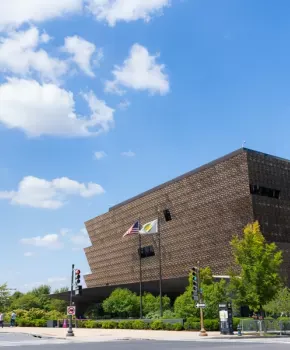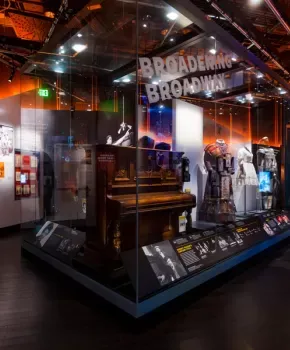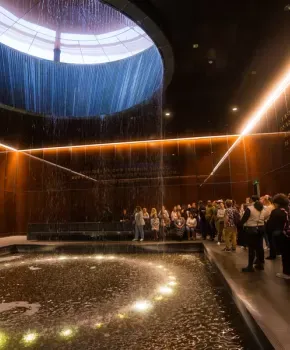Washington D.C., the U.S. capital, boasts a rich cultural and historical tapestry. Among its countless landmarks, the National Museum of African American History and Culture (NMAAHC) stands out as a unique historical treasure. This article delves into this remarkable museum, showcasing its compelling exhibits and architectural splendor.
The Smithsonian NMAAHC: A Unique Historical Gem
The NMAAHC, majestically situated on the National Mall, is more than just a building; it’s a living testament to the African American experience. Since opening on September 24, 2016, this four-level museum has become an essential destination for anyone seeking to understand the profound contributions and arduous journey of African Americans.
Located at 14th Street and Constitution Avenue NW, the NMAAHC is easily accessible via public transportation, particularly the Metrorail. The nearest stop, Federal Triangle, is serviced by the Blue, Orange, and Silver lines. The museum is open daily, welcoming visitors to explore its poignant historical narratives. Hours are 10:00 AM to 5:30 PM Tuesday through Sunday, and 12:00 PM to 5:30 PM on Mondays. On Mondays that coincide with Federal Holidays, the museum opens at 10:00 AM.

Uncovering Historical Treasures within the NMAAHC
Stepping inside the NMAAHC, visitors are immediately struck by the sheer scope and diversity of the artifacts on display. This modern edifice is a journey through African American history, culture, and art, encompassing both painful chapters and remarkable achievements. The museum addresses nearly every facet of the African American experience, including art, slavery, the Civil War, the Civil Rights Movement, sports, and more.
The museum’s architectural highlight is its striking exterior, designed by Ghanaian architect David Adjaye. The three-tiered bronze screen is not merely aesthetically pleasing; it holds deep symbolic meaning. It pays homage to the intricate ironwork crafted by enslaved African Americans in the South, a testament to their creativity and resilience.
The museum’s collection is a treasure trove, with 3,500 artifacts on permanent display and a total of 35,000 in its holdings. Each artifact tells a story, contributing to a comprehensive narrative of African American history and culture. Notable artifacts include a shawl given to Harriet Tubman by Queen Victoria, a training plane used by the Tuskegee Airmen, President Barack Obama’s 2009 inauguration invitation, and a boombox owned by Chuck D of Public Enemy.

Must-See Exhibits at the NMAAHC
Given the museum’s vast size and extensive collection, exploring the entire NMAAHC in a single visit can be challenging. However, the museum’s thematic exhibitions make it easier for visitors to delve into specific aspects of African American history and culture. Here are some highlights:
Musical Crossroads: A Journey Through Musical Heritage
The Musical Crossroads exhibit takes visitors on a sonic journey through the rich and diverse musical history of African Americans, from the earliest melodies created by enslaved Africans to contemporary genres. From jazz and blues to gospel and hip-hop, the exhibit highlights music’s role as a powerful form of expression, a tool for fighting for freedom, justice, and social change.
Slavery and Freedom: A Story of Tragedy and Hope
The Slavery and Freedom exhibit utilizes firsthand accounts and historical artifacts to tell the complex and emotional story of slavery. This exhibit traces the history of slavery from Africa and Europe in the 15th century through the Civil War and Reconstruction in the United States. It emphasizes the deep connection between slavery and American freedom, demonstrating how the story of slavery is integral to American politics, economics, and daily life, even today.
Defending Freedom, Defining Freedom & A Changing America: From Struggle to Hope
Continuing the historical journey, visitors encounter the Defending Freedom, Defining Freedom and A Changing America exhibits. [Defending Freedom, Defining Freedom] focuses on the Jim Crow era and the dawn of the Civil Rights Movement, highlighting the persistent struggle to forge cultural identity and community while changing the nation. [A Changing America] continues the story from 1968 to the present, encompassing the assassination of Martin Luther King, Jr., Barack Obama’s presidency, and the journey from the Black Panthers to the #BlackLivesMatter movement.

Conclusion: The NMAAHC – A Must-See Cultural and Historical Destination
The National Museum of African American History and Culture is more than a museum; it’s a vital historical repository, a vibrant cultural space that preserves and celebrates the stories, contributions, and experiences of African Americans. With its rich collection, insightful exhibits, and unique architecture, the NMAAHC offers visitors a deeply moving and meaningful journey through history. For a complete visit, consult the museum’s event calendar for information on online programs and special events.